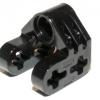Search the Community
Showing results for tags 'CVT'.
Found 2 results
-

[TC19] Extended motorcycle with a CVT
Zerobricks posted a topic in LEGO Technic, Mindstorms, Model Team and Scale Modeling
For TC19 I really wanted to do a motorcycle with an extended swing arm, I really like the aesthetic: Here's what progress I made in LDD. I want the motorcycle to be as narrow and slim as possible, hence the V6 is positioned longitudinally. And in real life. Because the elagonated swing arm produces higher forces, it's held in place by two small turntables, which eliminates friction on the secondary driveshaft. Notice something odd about the transmission? Originally i wanted to use a 4 speed gearbox, but since so many people did it already, I decided to use something different. I came up with a fully working CVT gearbox which uses two 2x2 cones and a rubber band to seamlessly change gear ratios between 1:2 and 2:1. The following GIF shows how the shifting lever moves the rubber band sideways using a simple linkage with the drivline powered- 13 replies
-
- drag
- motorcycle
-
(and 2 more)
Tagged with:
-
I really like the idea of continuously variable transmissions, where the transmission can shift smoothly and continuously along a range of ratios instead of moving from one fixed ratio to another. Inspired by Zblj's differential-based CVT and its development by Nico71, I wondered if it would be possible to build a spherical CVT similar to the NuVinci CVT, using Technic ball joints as the spheres. For those unfamiliar with spherical CVTs, the NuVinci site has a decent explanation. The goal is the same as for other CVTs, but the mechanism is different. The answer is: yes, such a thing can be built, but it is so limited in the torque it can transmit that it's of little practical value. In theory, one could get over the torque problem by gearing up between the motor and CVT's input, and then gearing down again between the CVT's output shaft and the wheels. In practice, I had limited success with this approach because of frictional losses in these two additional geartrains. However, I'm new to Technic and maybe one of you can solve this problem. If you do, please let me know! There are plenty of other features of the CVT that could probably stand improvement. For one, the spheres contact the side of the tires, pushing the tires away from the sphere. Ideally, the spheres would contact the edge of the tires, keeping the wheels from dislodging sideways. However, in practice there are two problems. The first is that this is hard to do while building using parts with standard stud- and half-stud distances (8mm and 4mm). The second is that if the two wheels are too close to one another, their faces tend to rub together. I tried using Bionicle Zamor/Chima spheres, which are much larger and therefore might allow a better wheel/sphere contact geometry without having the wheels too close to each other, but didn't find a good way to get them to work. I also tried a wide selection of small tires and wheels; none of them worked better than the wedge belt wheel and its tire, though maybe someone else can find a better solution. An early version of the CVT was also an Infinitely Variable Transmission (CVT-IVT), at least in theory. The sphere could rotate enough that the radius of rotation of the sphere where the output wheel contacted it was zero; this gave, in theory, infinite speed reduction and infinite torque multiplication. In practice, the output sphere stopped rotating - and stopped transmitting any torque - well before the sphere reached the theoretical infinite-torque angle. One happy accident I encountered while building the CVT is that while I planned for the shifting to be manually controlled, the CVT as built is actually automatic. As you apply a resistive torque to the output shaft, the spheres rotate of their own accord to slow the output and increase its torque. Note that if the tan axle pins in the pictures were not present, the spheres would keep rotating until the flat face of the ball joints (where the axle pin attaches) faced one of the wheels, which would then cease to be in contact with the sphere and cease to transmit rotation. OK, on to the pictures. Since I don't have a Flickr or Brickshelf account to host photos, I can only upload 3 small photos in this post; hopefully they'll be adequate. For some reason they upload out of order, so the first one is of the CVT partially assembled; the second shows the parts needed; and the third shows the completed assembly. Note that 8 of the lime connectors are connected to the 5x7 frames using black friction pins; the central 4 lime connectors use 3/4 pins instead, with the 1/2 stud portion inside the lime connector. This is to prevent the pins from rubbing against the ball joints.

